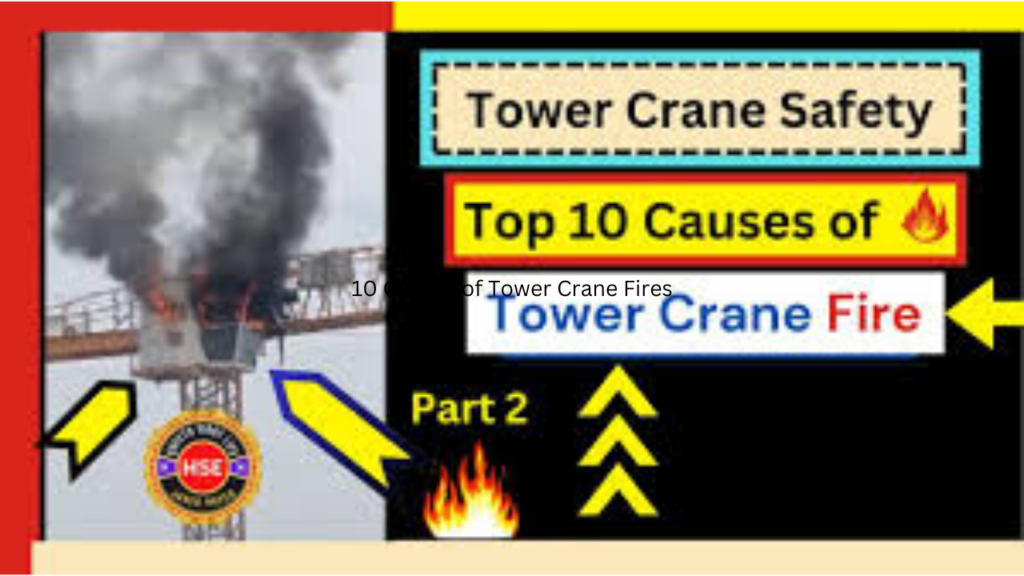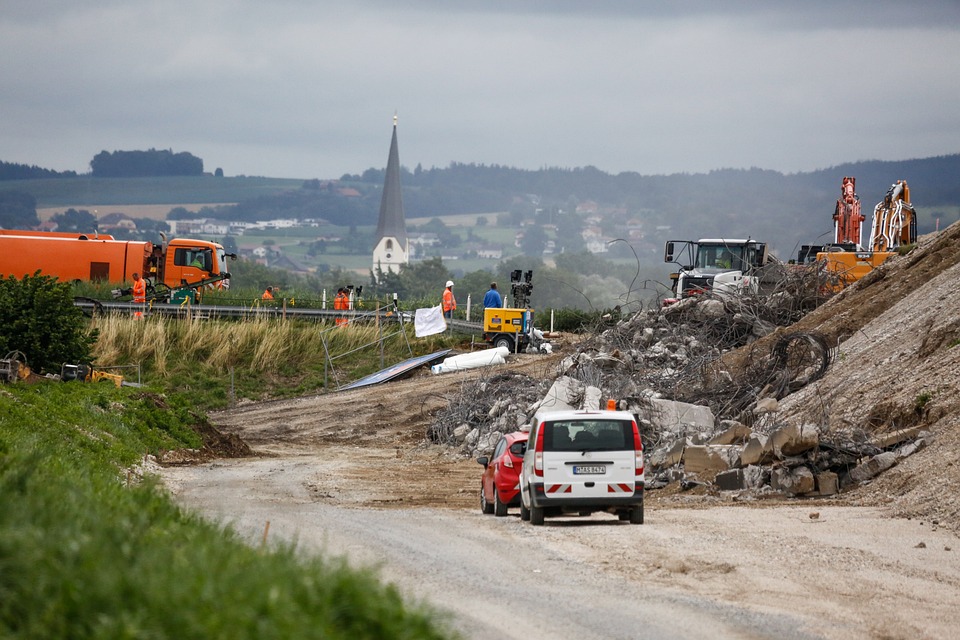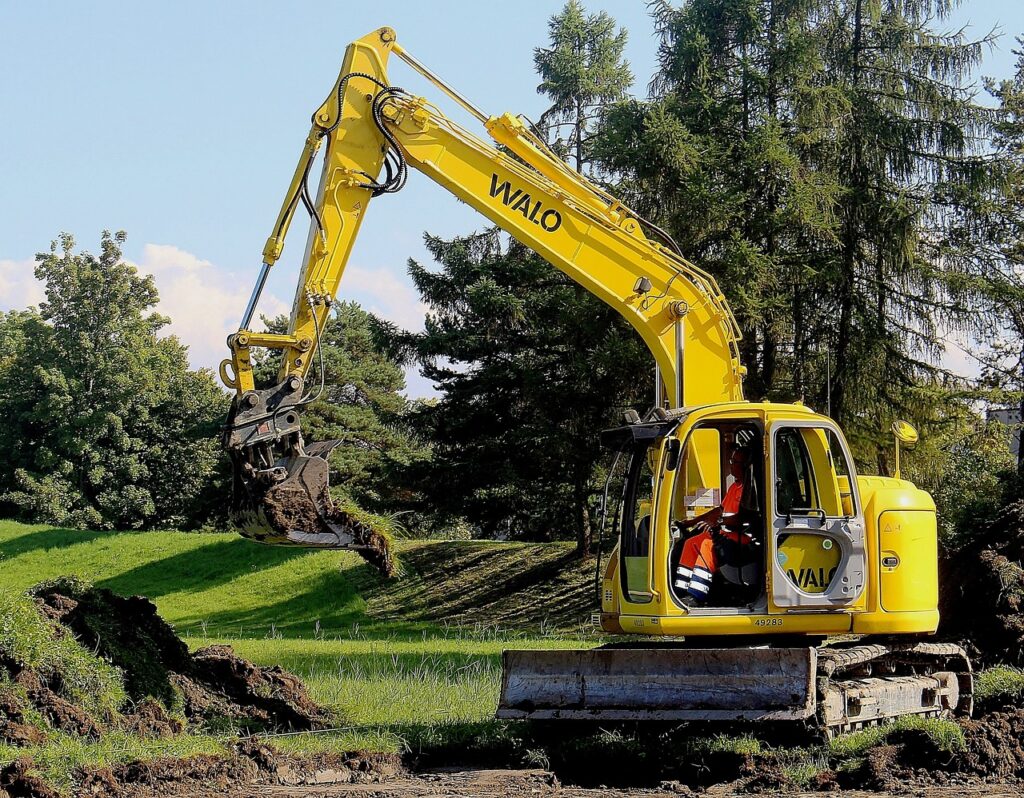Electrical Short Circuit
Your search for Top 10 Causes of Tower Crane Fires now ends.A short circuit in the electrical system of the cabin. Perhaps due to damaged wiring or overloaded circuits, could generate sparks and ignite nearby materials.
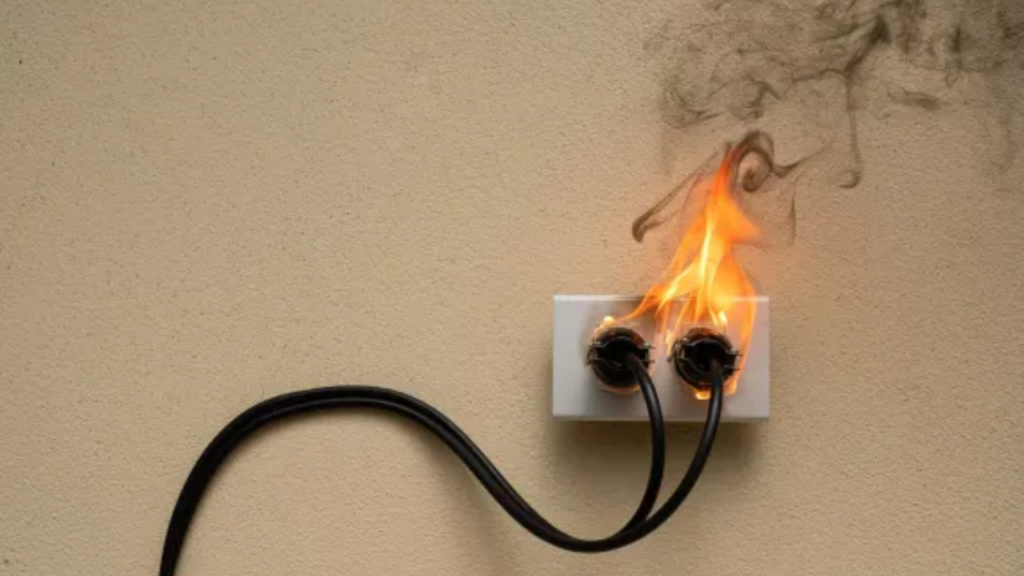
Damaged Wiring
Over time, the wiring within the tower crane’s electrical system may degrade due to factors. Such as wear and tear, exposure to harsh environmental conditions, or accidental damage during maintenance or operation. If the insulation around the wires becomes compromised. It can expose the conductive material, increasing the risk of a short circuit.
Overloaded Circuits
Tower cranes rely on electrical circuits to power various components within the cabin. Including lights, control panels, communication systems, and HVAC (Heating, Ventilation, and Air Conditioning) units. If these circuits are overloaded due to excessive demand or improper distribution of electrical loads. It can cause the wires to overheat, potentially leading to a short circuit.
Sparks Generation
When a short circuit occurs, a sudden surge of electrical current bypasses the intended pathway. Flows through the path of least resistance, generating intense heat. This heat can be sufficient to melt nearby insulation, ignite combustible materials, or cause sparks to form. Especially if the short circuit involves high-voltage components.
Ignition of Nearby Materials
If the short circuit happens in close proximity to flammable materials such as insulation generated can quickly ignite these materials. The confined space of the cabin can exacerbate the spread of flames. Making it challenging to contain the fire once it starts.
Limited Access for Extinguishing
Tower crane cabins are often located at significant heights, making access difficult for firefighters and emergency responders. Additionally, the confined space routes within the cabin can hinder efforts to extinguish the fire quickly and evacuate personnel safely.
Potential for Secondary Hazards
In addition to the immediate risk of fire. An electrical short circuit in the tower crane cabin can pose secondary hazards, such as smoke inhalationshock, or . These hazards can further endanger the safety of personnel on the construction site.
Impact on Crane Operation
A fire in the cabin can disrupt the normal operation of the tower crane. Leading to delays in construction activities and potentially compromising the structural integrity of the crane itself. The loss of control over the crane’s movements due to electrical failure can also pose risks to nearby workers and structures.
Faulty Equipment
Malfunctioning electrical appliances or equipment within the cabin, such as heaters, lights, or control panels, could malfunction and cause a fire.
Heaters
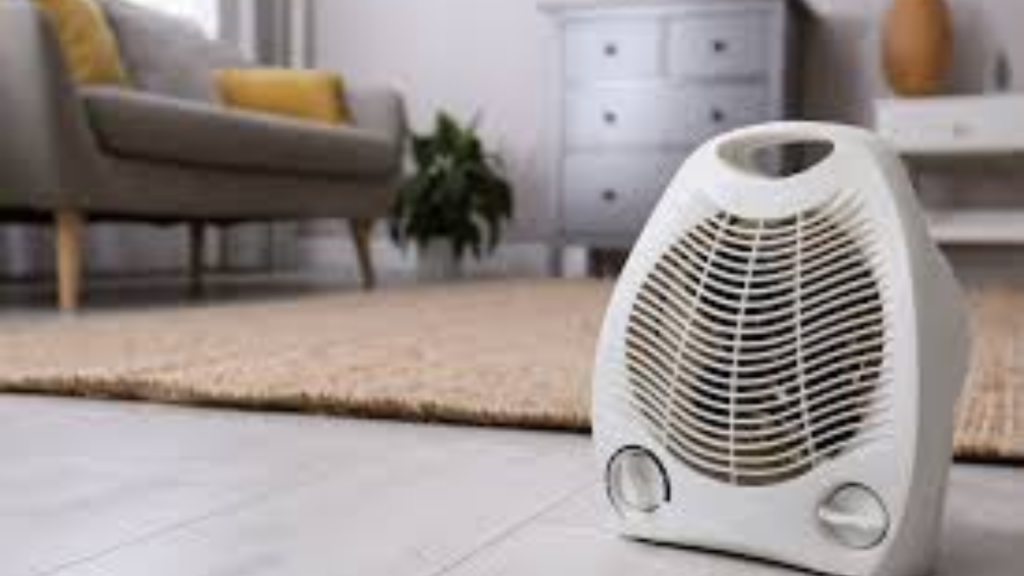
Tower crane cabins often include heating systems to ensure operators’ comfort, particularly in cold or inclement weather conditions. However, if these heaters are not properly maintained or have defective components, they can malfunction and become a fire hazard. For instance, an electric heater with damaged wiring or a malfunctioning thermostat could overheat. Leading to ignition of nearby materials such as curtains, upholstery, or insulation.
Lights
Lighting fixtures are essential for providing visibility within the tower crane cabin. However, faulty electrical connections, damaged bulbs, or overheating fixtures can increase the risk of a fire. If a light fixture shorts out or emits sparks due to a malfunction leading to a fire.
Control Panels
The control panels in the cabin are critical for operating the tower crane safely and efficiently. Malfunctioning control panels, whether due to electrical faults or component wear, can pose a fire risk. If they generate excessive heat or sparks. For example, a damaged control panel with exposed wiring could cause a short circuit. Leading to ignition of surrounding materials or components.
Electrical Appliances
Tower crane operators may use various electrical appliances within the cabin, such as microwaves, coffee makers, or portable heaters. If these appliances are faulty or have damaged cords, they can become ignition sources for a fire. Overloading electrical outlets with multiple appliances can also increase the risk of electrical faults and fires.
HVAC Systems
Heating, ventilation, and air conditioning (HVAC) systems are crucial for maintaining a comfortable and safe environment within the cabin. However, if the HVAC systems are not properly maintained or have defective components, they can pose a fire hazard. For example, a malfunctioning air conditioning unit with a clogged filter or damaged compressor could overheat, leading to a fire.
Regular Inspection and Maintenance
To mitigate the risk of fire due to faulty equipment and testing of all electrical appliances and systems crane cabin are essential. Qualified technicians should conduct routine checks to identify and address any potential issues before they escalate into fire hazards.
Emergency Response Preparedness
Despite preventive measures, fires can still occur due to equipment failures. Therefore, tower crane operators and personnel should be trained in emergency response procedures, including fire extinguisher operation, with emergency services. Having well-defined emergency response plans in place can help minimize the impact of a fire incident and ensure the safety.
Ignition from Electronics
Overheating or malfunctioning of electronic devices, such as computers, radios,could lead to a fire within the cabin.
Computers and Control Systems
Tower cranes often utilize sophisticated computer systems for monitoring and controlling various crane functions, such as positioning, and safety features. If these computers experience malfunctions due to hardware or software issues. They can generate excessive heat or electrical faults, leading to a fire. Overheating of computer components, such as processors or power supplies. Can occur if ventilation is inadequate or if dust and debris accumulate inside the cabin.
Radios and Communication Systems
Communication equipment, including radios, is essential for coordinating crane operations and ensuring the safety of personnel on the construction site. However, if these devices have defective batteries, chargers, or internal components, they can pose a fire risk. Lithium-ion batteries commonly used in electronic devices can be particularly hazardous if they malfunction or undergo thermal runaway. Leading to rapid overheating and ignition.
Navigation and Positioning Systems
Tower cranes may be equipped with GPS or other navigation systems to facilitate precise positioning and alignment during operation. While these systems are typically malfunctions or short circuits in their electronic components could lead to overheating and ignition. It’s essential to ensure that these systems are properly installed, maintained, and protected. From environmental factors that could compromise their integrity.
Monitoring and Alarm Systems
Tower cranes may be equipped with monitoring and alarm systems to alert operators to potential safety hazards. If these systems have faulty sensors, wiring, they may not function as intended, leading to delayed or inadequate response to critical situations. A fire originating from a malfunctioning monitoring or alarm system could quickly escalate if not detected and addressed promptly.
Preventive Measures
To mitigate the risk of ignition from electronics, tower crane operators and maintenance personnel should implement preventive measures. Such as regular inspection, testing, and maintenance of all electronic devices and systems within the cabin. This includes checking for signs of overheating, loose connections, or unusual noises that could indicate impending failures.
Emergency Response Planning-Top 10 Causes of Tower Crane Fires
Despite preventive measures, fires caused by electronic malfunctions can still occur. Therefore, having well-defined emergency response plans in place, including procedures for evacuating the cabin and extinguishing fires, is essential.
Hydraulic System Failure
A leak or rupture in the hydraulic system within the cabin could release hydraulic fluid. Which is flammable under certain conditions, leading to a fire.
Hydraulic Fluid Properties
Hydraulic systems in tower cranes use hydraulic fluid to transmit power. Control the movement of various components, such as the boom, jib. Fluid is typically highly flammable. In the event of a leak or rupture in the hydraulic system. Pressurized fluid can be released, creating a potential ignition source for a fire.
High Pressure
Hydraulic systems operate under high pressure to generate the force required for lifting heavy loads and controlling crane movements. If a hydraulic hose or fitting fails due to fatigue. The sudden release of pressurized fluid can create a spray or jet that can penetrate the cabin’s interior, increasing the likelihood of hydraulic fluid coming into contact with ignition sources.
Friction and Heat
Hydraulic system components, such as pumps, valves, cylinders, and hoses, are subject to friction and heat generation during normal operation. Over time, wear and tear or inadequate lubrication can increase friction levels. Leading to overheating and potential ignition of hydraulic fluid or surrounding materials if temperatures exceed the fluid’s flash point.
Seal and Hose Failures
Seals and hoses in hydraulic systems are vulnerable to degradation over time. Due to exposure to hydraulic fluid, environmental conditions, and mechanical stress. If seals degrade or hoses develop cracks or leaks, hydraulic fluid can escape. Posing a fire risk if it comes into contact with electrical components, or other ignition sources within the cabin.
Proximity to Electrical Components
Hydraulic systems and electrical systems often coexist within the confined space of the tower crane cabin. If a hydraulic system failure occurs near electrical components, such as control panels, wiring, or electronic devices, hydraulic fluid leakage. It can increase the risk of electrical shorts, sparks, or arcs, potentially igniting the flammable fluid and causing a fire.
Combustible Surroundings
The interior of the tower crane cabin may contain various materials that are susceptible to ignition. If hydraulic fluid leaks onto these combustible materials. It can act as a fuel source for a fire, exacerbating the severity of the incident and hindering firefighting efforts.
Preventive Maintenance
To mitigate the risk of hydraulic system failure leading to a fire. Regular inspection, maintenance, and testing of hydraulic components are essential. This includes monitoring hydraulic fluid levels, checking for leaks, inspecting hoses and fittings. Signs of wear or damage, and ensuring proper lubrication and sealing of system components.
Emergency Response Preparedness-Top 10 Causes of Tower Crane Fires
Despite preventive measures, hydraulic system failures leading to fires can still occur. Therefore, tower crane operators and personnel should train in emergency response procedures. Rapid response and effective communication are critical for minimizing the risk of injury and property damage in such situations.
Combustible Materials Storage
Improper storage of combustible materials like papers, rags, or cleaning supplies within the cabin. Could provide fuel for a fire if ignited accidentally.
Accumulation of Materials
Tower crane cabins, despite their limited space, may accumulate various materials and supplies necessary for crane operation and maintenance. These materials can include papers, rags, cleaning supplies, spare parts, personal belongings, and other items. If these materials are not properly store and organize. They can create clutter and increase the risk of fire hazards within the cabin.
Ignition Sources
Combustible materials stored within the cabin can act as fuel sources for a fire if ignited accidentally. Common ignition sources include electrical equipment, smoking materials, sparks from metal tools, hot surfaces, and malfunctioning appliances. If these ignition sources come into contact with combustible materials, they can quickly ignite, leading to a fire that can spread rapidly.
Chemical Hazards
Some cleaning supplies and maintenance chemicals stored within the cabin may contain flammable or combustible ingredients. Additionally, chemical fumes or vapors can pose health hazards to crane operators and personnel.
Poor Housekeeping Practices
Inadequate housekeeping practices within the cabin can contribute to the accumulation of combustible materials. Cluttered workspaces increase the likelihood of accidental ignition and hinder emergency response efforts in the event of a fire. Proper storage and disposal procedures enforced to minimize fire hazards and maintain a safe working environment.
Proximity to Heat Sources
Combustible materials stored within the cabin may be located near heat-generating equipment or components, such as heaters. If these materials are exposed to excessive heat or sparks, they can ignite and fuel a fire. Proper spacing and insulation between combustible materials and heat sources maintain to reduce the risk of ignition.
Preventive Measures
To mitigate the risk of fire due to combustible materials storage, tower crane operators and maintenance. Personnel should implement preventive measures such as regular inspection and cleanup of the cabin, proper storage and enforcement of smoking bans. Flammable materials should be stored in designated areas away from heat sources and containers should be tightly sealed.
Emergency Response Preparedness-Top 10 Causes of Tower Crane Fires
Despite preventive measures, fires caused by combustible materials storage can still occur. Therefore, tower crane operators and personnel should be trained in emergency response procedures. Rapid response and effective coordination are essential for minimizing the impact of a fire incident.
Smoking Ignition
Careless smoking within the cabin or nearby areas could lead to the ignition of combustible materials.
Smoking in Restricted Areas-Top 10 Causes of Tower Crane Fires
Tower crane cabins are often designated as no-smoking areas due to the presence of:
Flammable materials, electrical equipment, and confined spaces. However, if proper smoking policies are not enforced or if workers ignore these regulations. Individuals may engage in smoking within the cabin or nearby areas. Careless disposal of cigarette butts or lit cigarettes can lead to the ignition of combustible materials, such as papers, fabrics, or insulation.
Ignition Sources
Lit cigarettes, cigars, or smoking materials can act as ignition sources for a fire if they come into contact with flammable or combustible materials within the cabin. In the confined space of the cabin, even a small ember or spark from smoking materials can quickly ignite nearby surfaces, upholstery, or debris. Additionally, discarded cigarette butts or ashes can remain smoldering for extended periods, increasing the risk of ignition if they come into contact with combustible materials.
Flammable Materials Accumulation
Tower crane cabins may accumulate various combustible materials, such as papers, fabrics, cleaning supplies, or personal belongings. If smoking occurs within the cabin or nearby areas, these materials can provide fuel for a fire if ignited accidentally. Cluttered workspaces and poor housekeeping practices increase the likelihood of combustible materials being exposed to smoking materials and ignition sources.
Lack of Fire Safety Measures
In the absence of adequate fire safety measures or smoking policies, workers may not be aware of the risks associated with smoking in or around the tower crane cabin. Failure to enforce smoking bans or provide designated smoking areas can increase the likelihood of fire incidents and pose significant safety hazards to crane operators and personnel on the construction site.
Preventive Measures-Top 10 Causes of Tower Crane Fires
To mitigate the risk of fire due to smoking ignition, strict no-smoking policies should be enforced within the tower crane cabin and surrounding areas. Clear signage indicating no-smoking zones should be prominently displayed, and workers should be educated about the importance of fire safety and compliance with smoking regulations. Designated smoking areas with appropriate receptacles for cigarette disposal should be provided away from flammable materials and ignition sources.
Worker Training and Awareness-Top 10 Causes of Tower Crane Fires
Crane operators and construction workers should receive training on fire safety practices, including the dangers of smoking in restricted areas and the proper use of fire extinguishing equipment. Workers should be encouraged to report any violations of smoking policies or fire hazards observed on the construction site to prevent potential fire incidents.
Emergency Response Preparedness
Despite preventive measures, fires caused by smoking ignition can still occur. Therefore, tower crane operators and construction personnel should be prepared to respond effectively to fire emergencies, including evacuating the cabin, activating fire alarms, and using fire extinguishers to suppress small fires. Rapid response and communication with emergency services are critical for minimizing the impact of a fire incident and ensuring the safety of everyone on the construction site.
Fuel Leak
Leakage from fuel lines or tanks within the cabin could create a highly flammable environment, especially if the fuel comes into contact with hot engine components.
Presence of Fuel System
Tower cranes equipped with internal combustion engines, such as diesel-powered cranes, rely on fuel systems to operate. These systems include fuel tanks, lines, filters, pumps, and injectors, all of which are potential sources of fuel leaks. If any component within the fuel system becomes damaged, corroded, or improperly installed, it can lead to fuel leakage.
Fuel Types and Flammability
The fuel used in tower crane engines, such as diesel or gasoline, is highly flammable. Even a small amount of leaked fuel vaporizes quickly and can create a highly combustible atmosphere within the confined space of the cabin. Diesel fuel, in particular, has a relatively low flashpoint, meaning it can ignite at lower temperatures compared to other fuels.
Mechanical Wear and Tear
Over time, components of the fuel system may experience wear and tear due to vibration, friction, temperature fluctuations, and exposure to environmental elements. This wear can lead to degradation of seals, gaskets, hoses, and connections, increasing the likelihood of fuel leaks. Common areas of vulnerability include fuel line connections, tank seams, fuel filters, and injector seals.
Hot Engine Components
The engine and exhaust components of a tower crane generate significant heat during operation. If a fuel leak occurs in close proximity to these hot components, such as the engine block, exhaust manifold, or turbocharger, the leaked fuel can come into contact with hot surfaces, leading to rapid vaporization and ignition. Even a small fuel leak can escalate into a large fire if it reaches a hot engine component.
Electrical Ignition Sources
In addition to hot engine components, electrical ignition sources within the cabin pose a significant fire risk if exposed to leaked fuel vapors. Electrical sparks or arcs from wiring, switches, relays, or electrical appliances can ignite fuel vapors and trigger a fire.
Potential for Explosive Atmosphere
If a significant fuel leak occurs within the cabin, it can create an explosive atmosphere, especially if the leaked fuel accumulates in confined spaces or ventilation is inadequate. In such cases, even a small spark or ignition source can trigger a sudden explosion, resulting in catastrophic consequences for the crane and surrounding area.
Preventive Maintenance and Inspections–Top 10 Causes of Tower Crane Fires
To mitigate the risk of fuel leaks leading to fire incidents, regular preventive maintenance and inspections of the fuel system are essential. This includes checking for signs of fuel leakage, such as puddles or stains around fuel system components, abnormal fuel consumption, unusual engine noises, or odors of fuel vapors within the cabin. Prompt repair or replacement of worn or damaged fuel system components is crucial for preventing fuel leaks and ensuring crane safety.
Emergency Response Preparedness-Top 10 Causes of Tower Crane Fires
Tower crane operators and personnel should be prepared to respond effectively to fuel-related emergencies, including shutting off the crane’s engine, evacuating the cabin, and using fire extinguishers to suppress small fires. Rapid response and communication with emergency services are critical for minimizing the impact of a fire incident and ensuring the safety of everyone on the construction site.
Arson or Sabotage
Deliberate acts of arson or sabotage targeted at the crane’s operating cabin could result in a fire incident, posing a significant risk to personnel and property.
Malicious Intent
Arson or sabotage involves intentional acts of vandalism, destruction, or harm aimed at causing damage or disruption. Individuals with malicious intent may target tower crane operating cabins due to their visibility, accessibility, and potential to cause significant impact on construction projects.
Access to the Cabin
Tower crane cabins are often located at significant heights, making them accessible to crane operators and authorized personnel. However, if security measures are inadequate or if unauthorized individuals gain access to the construction site, they may be able to enter the cabin and commit acts of arson or sabotage.
Ignition Sources
Arsonists may use various ignition sources to start a fire within the cabin, such as matches, lighters, candles, or incendiary devices. Saboteurs may tamper with electrical systems, fuel lines, hydraulic systems, or other components to create conditions conducive to a fire incident.
Flammable Materials
Tower crane cabins contain various materials that are susceptible to ignition and combustion, including fabrics, insulation, plastics, papers, and electronic equipment. Arsonists may target these materials to accelerate the spread of fire and maximize damage to the cabin and its contents.
Impact on Crane Operation
A fire incident in the tower crane operating cabin can disrupt crane operations, leading to delays in construction activities and potential safety hazards for personnel on the construction site. Depending on the severity of the fire, the crane may be rendered inoperable, requiring extensive repairs or replacement.
Property Damage and Loss
Arson or sabotage incidents can result in significant property damage and financial losses for construction companies, contractors, and project stakeholders. In addition to damage to the crane cabin and equipment, fires can also spread to adjacent structures, materials, and machinery, causing further destruction and disruption to the construction project.
Risk to Personnel Safety
Deliberate acts of arson or sabotage pose a serious risk to the safety and well-being of personnel on the construction site. Fires can spread rapidly within the confined space of the cabin, making evacuation difficult for crane operators and nearby workers. Smoke inhalation, burns, and injuries from falling debris are among the potential risks associated with fire incidents caused by arson or sabotage.
Security Measures and Surveillance-Top 10 Causes of Tower Crane Fires
To mitigate the risk of arson or sabotage, construction companies should implement robust security measures and surveillance systems to monitor access to the construction site and deter unauthorized individuals. Security personnel should be trained to recognize suspicious behavior and respond effectively to potential threats.
Emergency Response Planning
Despite preventive measures, fires caused by arson or sabotage can still occur. Therefore, construction companies should have well-defined emergency response plans in place, including procedures for evacuating personnel, contacting emergency services, and minimizing the spread of fire. Rapid response and coordination with law enforcement agencies are essential for investigating the incident and apprehending perpetrators.
Improper Maintenance
Neglecting regular maintenance of the cabin’s components, such as HVAC systems, electrical connections, or insulation, could increase the risk of fire due to wear and tear.
HVAC Systems
The HVAC (Heating, Ventilation, and Air Conditioning) system in the tower crane cabin is essential for maintaining a comfortable and safe working environment for crane operators. However, if the HVAC system is not properly maintained, it can pose a fire risk. Dust, debris, and other contaminants can accumulate within the HVAC system over time, obstructing airflow and causing components such as filters, fans, and coils to overheat. Additionally, electrical components within the HVAC system, such as motors, switches, and wiring, may degrade due to wear and tear, increasing the risk of electrical faults and potential ignition sources.
Electrical Connections
Tower crane cabins contain various electrical components and systems, including lighting fixtures, control panels, communication equipment, and power outlets. Improper maintenance of electrical connections, such as loose or corroded wires, damaged insulation, or overloaded circuits, can lead to electrical faults, short circuits, and sparks. If these electrical faults occur in close proximity to combustible materials or insulation, they can ignite a fire within the cabin.
Insulation
Insulation plays a crucial role in regulating temperature and preventing heat loss within the tower crane cabin. However, if insulation materials become damaged, degraded, or compromised, they can pose a fire hazard. For example, insulation around electrical wiring or HVAC ductwork may deteriorate over time, exposing the underlying components to heat and increasing the risk of ignition. Inadequate insulation can also contribute to the spread of fire within the cabin by allowing flames to penetrate walls, floors, or ceilings.
Wear and Tear
Tower crane cabins are subjected to harsh environmental conditions, including temperature fluctuations, humidity, vibration, and exposure to dust, dirt, and debris. Over time, these factors can cause mechanical components, structural elements, and surface finishes to degrade, corrode, or deteriorate. Neglecting regular maintenance and inspection of cabin components can exacerbate wear and tear, leading to equipment failure, malfunction, and increased fire risk. For example, worn bearings, seals, or gaskets in mechanical systems may leak fluids or generate excessive friction, increasing the likelihood of overheating and ignition.
Fire Suppression Systems
Tower crane cabins may be equipped with fire suppression systems, such as extinguishers, sprinklers, or suppression agents, to mitigate the risk of fire incidents. However, if these systems are not properly maintained, they may fail to function effectively in the event of a fire. For example, expired or discharged fire extinguishers, clogged sprinkler heads, or malfunctioning suppression agents can compromise the cabin’s fire safety measures, allowing fires to escalate and spread unchecked.
Preventive Maintenance Program
To mitigate the risk of fire due to improper maintenance, construction companies should implement a comprehensive preventive maintenance program for tower crane cabins. This program should include regular inspection, cleaning, lubrication, adjustment, and repair of cabin components, systems, and equipment. Qualified technicians should be responsible for conducting maintenance tasks according to manufacturer recommendations, industry standards, and regulatory requirements. Documentation of maintenance activities, including inspection reports, work orders, and service records, should be maintained for compliance and accountability purposes.
Training and Awareness-Top 10 Causes of Tower Crane Fires
Crane operators and maintenance personnel should receive training on the importance of proper maintenance practices, fire safety protocols, and emergency response procedures. They should be educated about the potential fire hazards associated with neglecting maintenance and the critical role of preventive measures in ensuring the safety of crane operations and personnel on the construction site.
Continuous Improvement
Construction companies should regularly review and update their maintenance procedures, protocols, and training programs to address emerging risks, technological advancements, and regulatory changes. Continuous improvement efforts should focus on enhancing the reliability, efficiency, and safety of tower crane cabins through proactive maintenance practices and risk management strategies.
Overheating from Overuse:
Continuous operation of the crane without adequate rest periods or in extreme weather conditions could cause components within the cabin to overheat, potentially leading to a fire.
Continuous Operation
Tower cranes are often used for extended periods during construction projects, especially in high-demand situations where tight deadlines must be met. Continuous operation of the crane without adequate rest periods can put significant strain on its components, including those within the cabin. Over time, this continuous stress can lead to overheating of critical systems and increase the risk of fire.
Mechanical Components
The cabin houses various mechanical components essential for crane operation, such as motors, gears, bearings, and hydraulic systems. Continuous operation of these components without sufficient rest or cooling periods can cause them to generate excessive heat due to friction, wear, and mechanical stress. If the temperature exceeds safe operating limits, it can lead to component failure or malfunction, potentially resulting in a fire.
Electrical Systems
Tower crane cabins contain numerous electrical systems and components, including motors, control panels, wiring, and lighting fixtures. Continuous operation of electrical systems can lead to increased electrical resistance, which in turn generates heat. If the electrical components are not adequately ventilated or cooled, the accumulated heat can cause insulation breakdown, electrical shorts, or component failures, leading to a fire.
Extreme Weather Conditions
Operating tower cranes in extreme weather conditions, such as high temperatures, humidity, or direct sunlight exposure, can exacerbate the risk of overheating. Elevated ambient temperatures can increase the thermal load on cabin components, making it more challenging for them to dissipate heat effectively. Additionally, extreme weather conditions can affect the performance and reliability of cooling systems, further increasing the risk of overheating and fire.
Insufficient Cooling Systems
Tower crane cabins may be equipped with HVAC (Heating, Ventilation, and Air Conditioning) systems or other cooling mechanisms to regulate temperature and maintain a comfortable working environment for crane operators. However, if these cooling systems are inadequate or malfunctioning, they may fail to effectively dissipate heat from the cabin, leading to overheating of components. Poor ventilation or blockages in air ducts can further restrict airflow and exacerbate the problem.
Human Factors
Crane operators and construction personnel may inadvertently contribute to the risk of overheating by overloading the crane or operating it beyond its recommended capacity. Excessive loads can put additional strain on crane components, increasing the heat generated during operation. Similarly, improper operation or maintenance practices, such as failure to lubricate moving parts or monitor fluid levels, can accelerate component wear and overheating.
Preventive Measures-Top 10 Causes of Tower Crane Fires
To mitigate the risk of overheating from overuse, construction companies should implement preventive measures such as adhering to recommended operating limits, scheduling regular maintenance and inspection of crane components, and providing adequate rest periods for crane operators and equipment. Additionally, monitoring cabin temperature and humidity levels, especially during periods of high demand or extreme weather conditions, can help identify potential overheating issues before they escalate into fire hazards. Prompt response to warning signs of overheating, such as abnormal noises, smells, or temperature readings, is essential for preventing fire incidents and ensuring the safety of crane operations and personnel on the construction site.

